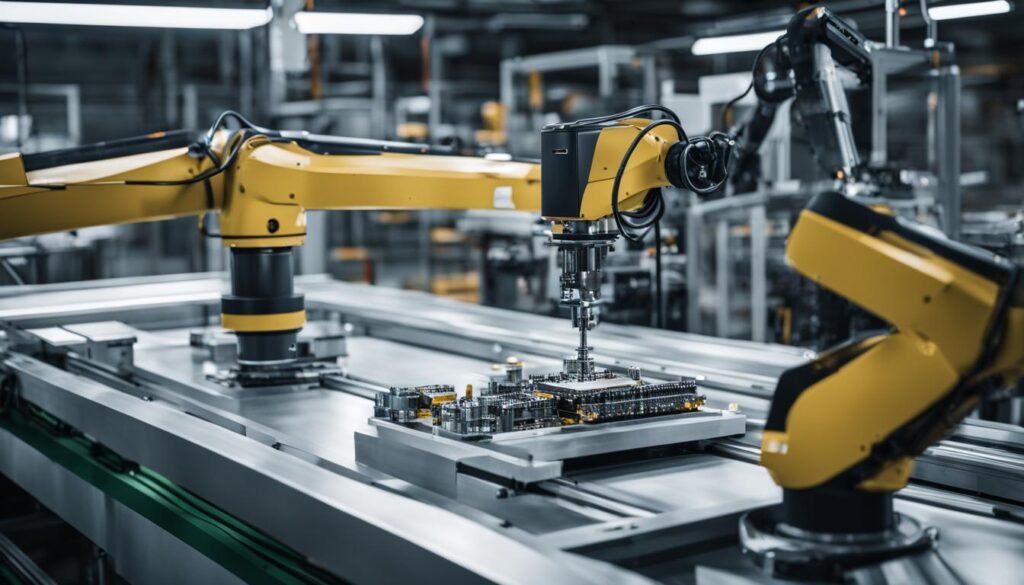
Streamline Operations with AI-Robotics Automation Today!

AI-robotics automation is revolutionizing industries across the board. With advancements in artificial intelligence, machine learning, and automation technology, businesses can streamline their operations and achieve improved efficiency and productivity. By implementing intelligent automation systems, companies can harness the power of AI-driven robotics to automate tasks and processes, reducing manual labor and human error. This transformative technology offers a range of benefits, from increased speed and accuracy to cost savings and enhanced scalability. Embracing AI-robotics automation is the key to staying competitive in today's fast-paced business landscape.
Key Takeaways:
- AI-robotics automation revolutionizes industries through advanced technology.
- Implementing intelligent automation systems improves efficiency and productivity.
- AI-driven robotics automates tasks, reducing manual labor and errors.
- AI-robotics automation offers speed, accuracy, cost savings, and scalability.
- Embracing AI-robotics automation ensures competitiveness in business.
- What is AI-robotics automation?
- How does AI-robotics automation benefit businesses?
- How is AI-robotics automation being utilized in ophthalmology?
- What impact can AI-robotics automation have on eye care delivery?
- Is programming the only skill required in data science?
- How does programming contribute to data science?
The Role of AI-Robotics Automation in Ophthalmology
In the field of ophthalmology, AI-robotics automation is making significant advancements. Chatbot technology, powered by artificial intelligence, is being utilized to improve healthcare services and patient experiences. These chatbots can provide round-the-clock support, address common inquiries about eye health, facilitate appointment scheduling, and offer preliminary guidance on eye conditions. By integrating chatbots into ophthalmology practices, accessibility, operational efficiency, and patient satisfaction can be greatly enhanced.
Additionally, AI-driven conversational platforms are improving search capabilities, enhancing communication, and providing access to specialized literature in the medical field. The utilization of AI-robotics automation in ophthalmology has the potential to reshape eye care delivery, improve outcomes, and provide essential information and support to patients.
See Also... Boost Your Business with AI-Sales Optimization Strategies
Boost Your Business with AI-Sales Optimization StrategiesWith the advancements in robotic process automation and AI-driven robotics, automated systems are transforming the way ophthalmologists diagnose and treat eye conditions. Robots are being utilized to perform precise surgical procedures, including cataract surgery and laser vision correction. These advanced robotics enable high precision and accuracy, leading to better surgical outcomes and faster recovery for patients. By leveraging AI-driven robotics, ophthalmologists can enhance their capabilities, expand treatment options, and ultimately improve the quality of care provided to patients.
Debunking the Myth: The Role of Programming in Data Science
Contrary to popular belief, data science is not solely dependent on programming. While programming is undoubtedly an integral part of the field, it represents just one facet of the diverse skill set required for success. Data scientists harness their expertise in programming, statistics, and critical thinking to unlock the power of data and drive meaningful insights.
Programming serves as a tool that empowers data scientists to automate processes, manipulate large datasets, perform complex computations, and visualize data patterns. By leveraging programming languages such as Python or R, data scientists can efficiently handle and analyze vast volumes of data. These skills enable them to build sophisticated models and algorithms, laying the foundation for machine learning and automation technologies.
See Also... Revolutionize Your Business with AI-Sales Forecasting Today!
Revolutionize Your Business with AI-Sales Forecasting Today!However, it is crucial to recognize that data science encompasses more than just programming. Proficiency in statistical analysis, data manipulation techniques, and problem-solving abilities are equally essential. A data scientist employs their programming skills in tandem with their broader expertise to extract meaningful insights from complex datasets, driving decision-making processes and enabling businesses to gain a competitive edge.
So, while programming is indeed a fundamental aspect of data science, it is important to view it as a means to an end rather than the sole focus. By understanding the diverse skill set required for data science, including programming alongside statistical knowledge and critical thinking, professionals can truly harness the power of automation technology, artificial intelligence, and machine learning to navigate the vast landscape of data and extract valuable insights.
FAQ
What is AI-robotics automation?
AI-robotics automation is the implementation of artificial intelligence and robotics technology to automate tasks and processes, improving efficiency and productivity in various industries.
See Also... Improve Efficiency with AI-Sales Process Automation Today
Improve Efficiency with AI-Sales Process Automation TodayHow does AI-robotics automation benefit businesses?
AI-robotics automation offers benefits such as increased speed and accuracy, cost savings, reduced manual labor, and enhanced scalability, allowing businesses to stay competitive in the fast-paced business landscape.
How is AI-robotics automation being utilized in ophthalmology?
In ophthalmology, AI-robotics automation is being used to enhance healthcare services and patient experiences through the integration of chatbot technology, which provides round-the-clock support, appointment scheduling, and guidance on eye conditions.
What impact can AI-robotics automation have on eye care delivery?
The utilization of AI-robotics automation in ophthalmology has the potential to reshape eye care delivery, improve outcomes, and provide essential information and support to patients.
Is programming the only skill required in data science?
No, programming is just one aspect of data science. Data scientists also need statistical knowledge, critical thinking, and problem-solving abilities to analyze data, build models, and drive insights.
How does programming contribute to data science?
Programming allows data scientists to automate processes, manipulate data, perform complex computations, and visualize data patterns, enabling efficient data analysis, modeling, and automation.
Source Links
- https://citylife.capetown/uncategorized/is-data-science-heavy-in-programming/500405/
- https://www.mdpi.com/2075-4426/13/12/1679
- https://newsunion.biz.id/trend-micro-gains-the-expertise-built-into-aws-to-simplify-and-accelerate-cloud-success/
If you want to know other articles similar to Streamline Operations with AI-Robotics Automation Today! you can visit the Blog category.
Leave a Reply






Related Post...